Parametric Effects on the Mixing Efficiency of Resonant Acoustic Mixing Technology for High-Viscosity Mixture: A Numerical Study
Abstract
1. Introduction
2. Materials and Mixing Methods
2.1. Properties of Materials
2.2. Mix Compositions
2.3. The RAM Setup
2.4. Numerical Simulations
3. Results and Discussions
3.1. Mechanism of Vertically Vibrated RAM Process
3.2. Effects of Different Parameters on the Mixing Process
3.2.1. Effect of Amplitude on the Mixing Process
3.2.2. Effects of Frequency on the Mixing Process
3.2.3. Effects of Fill Level on the Mixing Process
3.2.4. Effects of Vessel Geometry on the Mixing Process
3.3. The Overall Comparison
4. Conclusions
- (1)
- This study established a finite element model of the resonance acoustic mixing system in ANSYS workbench, performed modal analysis, and compared it with the operating frequency. The results show that the designed structure’s natural frequency is lower than the operating frequency, so that resonance or damage is avoided.
- (2)
- The dynamic mesh parameters were defined, the initial conditions of the simulation were set, and the materials were filled according to the specified ratio.
- (3)
- According to the shape of the inner cavity of the mixing vessel, the corresponding three-dimensional (3D) flow field model was established in the Fluent. Through simulation calculation, the mixing efficiency of the mixing vessel was analyzed.
- (4)
- Using the control volume method, the influence of vibrational frequency and amplitude on the mixing efficiency of the RAM was analyzed.
- (5)
- The results show that amplitude and frequency both have greater influence in the mixing efficiency of the RAM, because, in the simulations with larger values of amplitude and smaller values of frequency, and vice versa, the mixing uniformity is not good enough. However, when the amplitude and frequency both have the largest given values, such as in the simulations of 5 mm, 60 Hz, and 60 s; 5 mm, 40 Hz, and 60 s; 3 mm, 60 Hz, and 60 s; and 3 mm, 40 Hz, and 60 s, the mixing efficiency is very good.
- (6)
- Mixing performance was found to be independent of time. The longer mixing time did not affect the mixing process significantly as it was mainly dependent on the amplitude as well as on frequency. In addition, in between amplitude and frequency, the efficiency was more dependent on amplitude when it was compared with higher values of frequency.
- (7)
- These simulations can be used for understanding the mixing of highly viscous materials by using resonant acoustic mixing technology’s approach. This approach could potentially be used for pharmaceutical blending as well as for explosive applications.
5. Recommendations for the Future Work
Author Contributions
Funding
Data Availability Statement
Conflicts of Interest
References
- Paul, E.L.; Atiemo-Obeng, V.; Kresta, S. Handbook of Industrial Mixing; Wiley Online Library: Hoboken, NJ, USA, 2004. [Google Scholar]
- Osorio, J.G.M.; Fernando, J. Evaluation of resonant acoustic mixing performance. Powder Technol. 2015, 278, 46–56. [Google Scholar] [CrossRef]
- Asachi, M.; Nourafkan, E.; Hassanpour, A. A review of current techniques for the evaluation of powder mixing. Adv. Powder Technol. 2018, 29, 1525–1549. [Google Scholar] [CrossRef]
- Muzzio, F.J.; Llusa, M.; Goodridge, C.L.; Duong, N.H.; Shen, E. Evaluating the mixing performance of a ribbon blender. Powder Technol. 2008, 186, 247–254. [Google Scholar] [CrossRef]
- Nance, D.V. An Examination of the Resonant Acoustic Mixers Flow Field; Air Force Research Lab Eglin Afb Fl Munitions Directorate; p. 2013. Available online: https://apps.dtic.mil/sti/citations/ADA590055 (accessed on 23 November 2022).
- Muzzio, F.J.; Shinbrot, T.; Glasser, B.J. Powder technology in the pharmaceutical industry: The need to catch up fast. Powder Technol. 2002, 124, 1–7. [Google Scholar] [CrossRef]
- Andrews, M.R.; Collet, C.; Wolff, A.; Hollands, C. Resonant acoustic® mixing: Processing and safety. Propellants Explos. Pyrotech. 2020, 45, 77–86. [Google Scholar] [CrossRef]
- Vandenberg, A.; Wille, K. Evaluation of resonance acoustic mixing technology using ultra high performance concrete. Constr. Build. Mater. 2018, 164, 716–730. [Google Scholar] [CrossRef]
- Leung, D.H.; Lamberto, D.J.; Liu, L.; Kwong, E.; Nelson, T.; Rhodes, T.; Bak, A. A new and improved method for the preparation of drug nanosuspension formulations using acoustic mixing technology. Int. J. Pharm. 2014, 473, 10–19. [Google Scholar] [CrossRef]
- Batmaz, E.; Sandeep, K.P. Integration of ResonantAcoustic® mixing into thermal processing of foods: A comparison study against other in-container sterilization technologies. J. Food Eng. 2015, 165, 124–132. [Google Scholar] [CrossRef]
- Claydon, A.J.; Patil, A.N.; Gaulter, S.; Kister, G.; Gill, P.P. Determination and optimisation of Resonant Acoustic Mixing (RAM) efficiency in Polymer Bonded eXplosive (PBX) processing. Chem. Eng. Process.-Process Intensif. 2022, 173, 108806. [Google Scholar] [CrossRef]
- Han, D.F. Raissa Douglas Influence of high mixing intensity on rheology, hydration, and microstructure of fresh state cement paste. Cem. Concr. Res. 2016, 84, 95–106. [Google Scholar] [CrossRef]
- Han, D.; Ferron, R.D. Effect of mixing method on microstructure and rheology of cement paste. Constr. Build. Mater. 2015, 93, 278–288. [Google Scholar] [CrossRef]
- Juilland, P.; Kumar, A.; Gallucci, E.; Flatt, R.J.; Scrivener, K.L. Effect of mixing on the early hydration of alite and OPC systems. Cem. Concr. Res. 2012, 42, 1175–1188. [Google Scholar] [CrossRef]
- Zhan, X.; He, Y.; Sun, Z.; Shen, B.; Li, X. Mixing Characteristics of High-Viscosity Fluids under Forced Vertical Vibration. Chem. Eng. Technol. 2020, 43, 1327–1335. [Google Scholar] [CrossRef]
- Zhan, X.; Sun, Z.; He, Y.; Shen, B.; Shi, T.; Li, X. Characterization of fluid mixing in a closed container under horizontal vibrations. Can. J. Chem. Eng. 2019, 97, 1931–1938. [Google Scholar] [CrossRef]
- Cheng, W.; Mu, J.; Li, K.; Xie, Z.; Zhang, P.; An, C.; Ye, B.; Wang, J. Evolution of HTPB/RDX/Al/DOA mixed explosives with 90% solid loading in resonance acoustic mixing process. J. Energetic Mater. 2021, 1–20. [Google Scholar] [CrossRef]
- Hashimoto, H.; Sudo, S. Surface disintegration and bubble formation in vertically vibrated liquid column. AIAA J. 1980, 18, 442–449. [Google Scholar] [CrossRef]
- Tso, C.P.; Lim, T.L.; Low, L.C.; Lee, G.C.; Yap, T.C. Fifteenth Asian Congress of Fluid Mechanics (15ACFM). J. Phys. Conf. Ser. 2017, 822, 011001. [Google Scholar] [CrossRef]
- Zeff, B.W.; Kleber, B.; Fineberg, J.; Lathrop, D.P. Singularity dynamics in curvature collapse and jet eruption on a fluid surface. Nature 2000, 403, 401–404. [Google Scholar] [CrossRef] [PubMed]
- Hashimoto, H.; Sudo, S. Drop formation mechanism in a vertically vibrated liquid column. AIAA J. 1987, 25, 727–732. [Google Scholar] [CrossRef]
- Nelson, A.; Miller, M. Resonant Acoustic Mixing of High-Energy Composite Materials. In SERDP. ESTCP Symposium; Resodyn Corporation: Butte, MT, USA, 2018. [Google Scholar]
- Hashimoto, H.; Sudo, S. Dynamic behavior of stratified fluids in a rectangular container subject to vertical vibration. Bull. JSME 1985, 28, 1910–1917. [Google Scholar] [CrossRef]
- Osorio, J.G.; Hernández, E.; Romañach, R.J.; Muzzio, F.J. Characterization of resonant acoustic mixing using near-infrared chemical imaging. Powder Technol. 2016, 297, 349–356. [Google Scholar] [CrossRef]
- Wang, Y.; Osorio, J.G.; Li, T.; Muzzio, F.J. Controlled shear system and resonant acoustic mixing: Effects on lubrication and flow properties of pharmaceutical blends. Powder Technol. 2017, 322, 332–339. [Google Scholar] [CrossRef]
- Nagapudi, K.; Umanzor, E.Y.; Masui, C. High-throughput screening and scale-up of cocrystals using resonant acoustic mixing. Int. J. Pharm. 2017, 521, 337–345. [Google Scholar] [CrossRef] [PubMed]
- Zhang, S.; Wang, X. Effect of vibration parameters and wall friction on the mixing characteristics of binary particles in a vertical vibrating container subject to cohesive forces. Powder Technol. 2023, 413, 118078. [Google Scholar] [CrossRef]
- Pahl, M.H.; Wittreck, H. Three-dimensional vibrational mixing. Chem. Eng. Technol. Ind. Chem.-Plant Equip.-Process Eng.-Biotechnol. 1997, 20, 511–521. [Google Scholar] [CrossRef]
- Yang, S. Density effect on mixing and segregation processes in a vibrated binary granular mixture. Powder Technol. 2006, 164, 65–74. [Google Scholar] [CrossRef]
- Katayama, T.; Aoyama, E.; Yamamoto, K.; Sakaue, S. Evaluation of two-component powder mixing by vertical vibration: Investigation of powder behavior and mixed state by internal pressure fluctuation. J. Mater. Process. Technol. 2004, 155, 1571–1576. [Google Scholar]
- Osorio, J.G.; Sowrirajan, K.; Muzzio, F.J. Effect of resonant acoustic mixing on pharmaceutical powder blends and tablets. Adv. Powder Technol. 2016, 27, 1141–1148. [Google Scholar] [CrossRef]
- Moshe, S.S.B.; Ronen, Z.; Dahan, O.; Weisbrod, N.; Groisman, L.; Adar, E.; Nativ, R. Sequential biodegradation of TNT, RDX and HMX in a mixture. Environ. Pollut. 2009, 157, 2231–2238. [Google Scholar] [CrossRef]
- Urbanski, T.; Laverton, S.; Ornaf, W. Chemistry and Technology of Explosives; Pergamon Press: Oxford, UK, 1964; Volume 1. [Google Scholar]
- Dobratz, B.M. Ethylenediamine Dinitrate and its Eutectic Mixtures: A Historical Review of the Literature to 1982. 1983. Available online: https://apps.dtic.mil/sti/citations/ADA131641 (accessed on 23 November 2022).
- Lawless, Z.D.; Hobbs, M.L.; Kaneshige, M.J. Thermal conductivity of energetic materials. J. Energetic Mater. 2020, 38, 214–239. [Google Scholar] [CrossRef]
- RAM Technical White Paper; Resodyn Corporation: Butte, MT, USA, 2009.
- S., L.J.T.; Miller, P.L. Idustrial Outcomes in Resonant Acoustic_Mixing. In Mix Power: Resodyn Forum; Resodyne Acoustic Mixers: Butte, MT, USA, 2013. [Google Scholar]
- Howe, H.W.; Warriner, J.J.; Cook, A.M.; Coguill, S.L.; Farrar, L.C. Apparatus and Method for Resonant-Vibratory Mixing. U.S. Patent No. 7,188,993, 13 March 2007. [Google Scholar]
- Coguill, S.; Farrar, L.; Mixers, R.A. Resodyn Acoustic. Resonant acoustic mixing of PBX. In International Pyrotechnics Seminar; Resodyn Acoustic Mixers: Butte, MT, USA, 2014. [Google Scholar]
- Coguill, S.; Martineau, Z.; Martineau, Z.R. Vessel Geometry and Fluid Properties Influencing Mix Behavior for ResonantAcoustic Mixing Processes. In Proceedings of the 38th International Pyrotechnics Seminar, Denver, CO, USA, 10–15 June 2012. [Google Scholar]
- Keller, A.V.; Vandromme, D.; Zaleski, S. Proceedings of the 6th International Conference on Liquid Atomization and Sprays Systems Process, Rouen, France, 18–22 July 1994; Descriçao, E., Ed.; Begell House: Danbury, CT, USA, 1994. [Google Scholar]
- Bale, S.; Clavin, K.; Sathe, M.; Berrouk, A.S.; Knopf, F.C.; Nandakumar, K. Mixing in oscillating columns: Experimental and numerical studies. Chem. Eng. Sci. 2017, 168, 78–89. [Google Scholar] [CrossRef]
- Harewood, F.J.; McHugh, P.E. Investigation of finite element mesh independence in rate dependent materials. Comput. Mater. Sci. 2006, 37, 442–453. [Google Scholar] [CrossRef]
- Ramayee, L.; Supradeepan, K. Grid convergence study on flow past a circular cylinder for beginners. In AIP Conference Proceedings; AIP Publishing LLC: New York, NY, USA, 2021. [Google Scholar]
- Almeida, Z.; da Silva, Y.P.; Jr, E.F.; Vianna, S. Assessment of richardson extrapolation method in the cfd mesh convergence pro-cess. In I Congresso Brasileiro de Fluidodinamica Computational; PB: Campina Grande, Brazil, 2016. [Google Scholar]
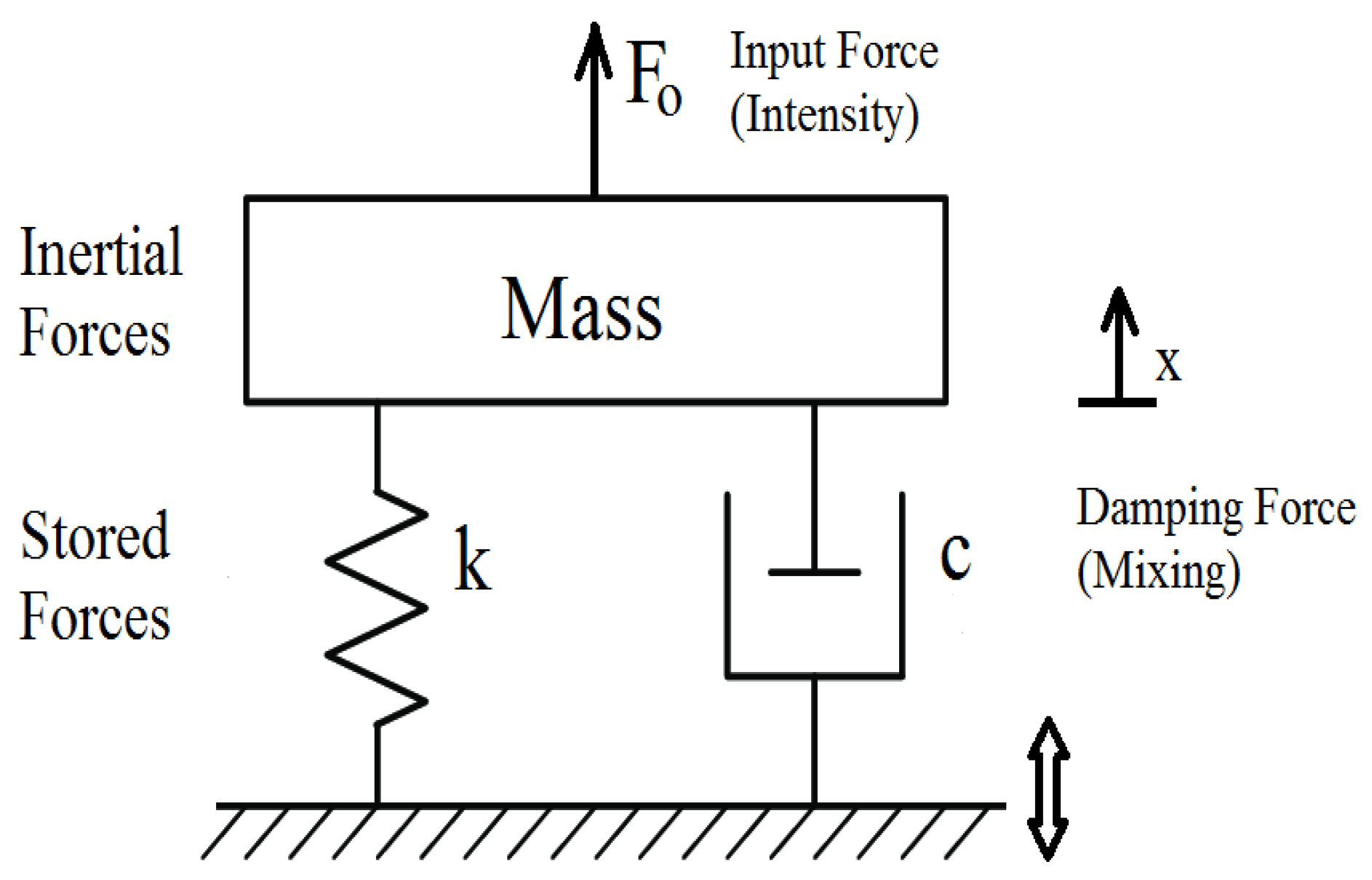

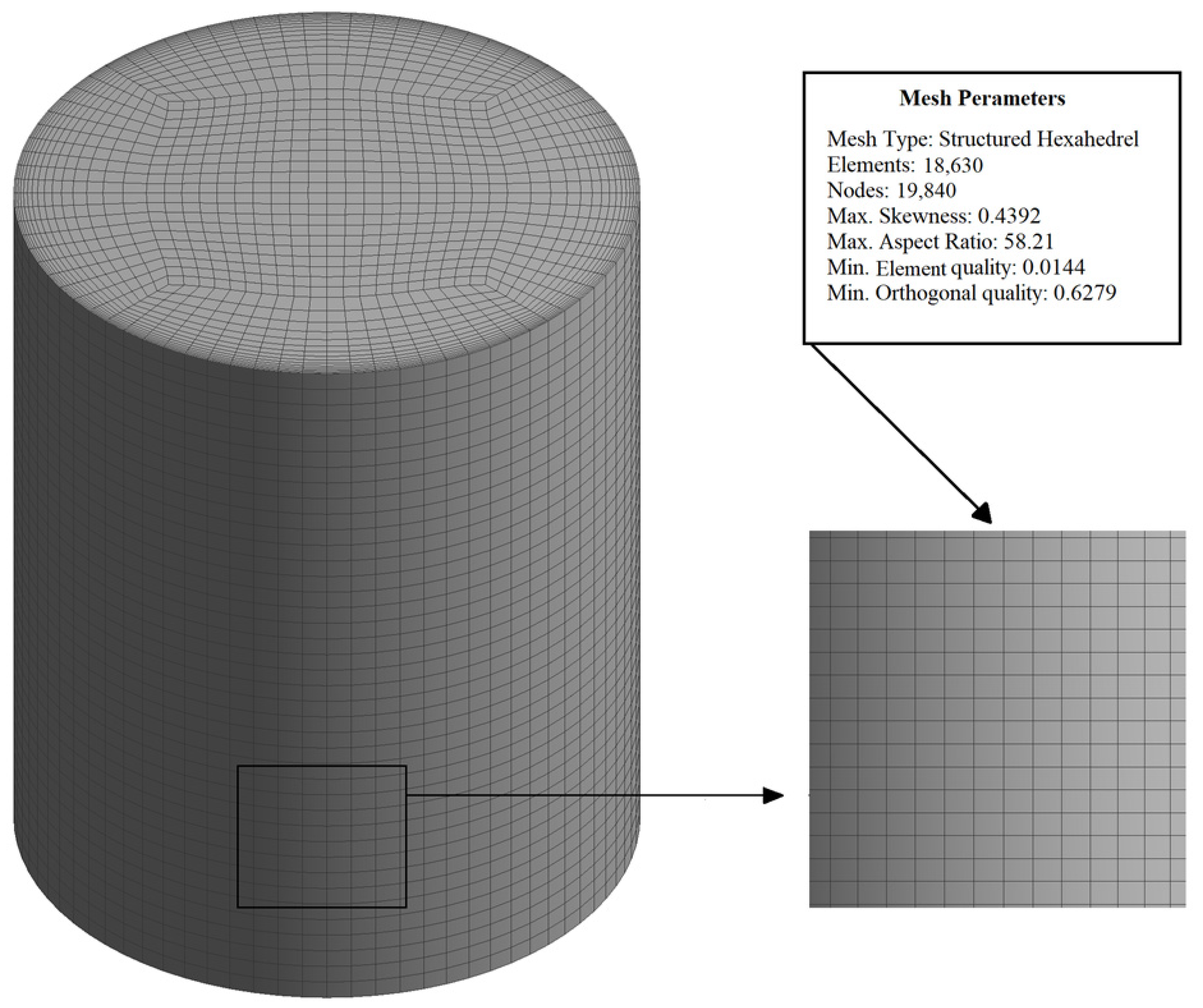
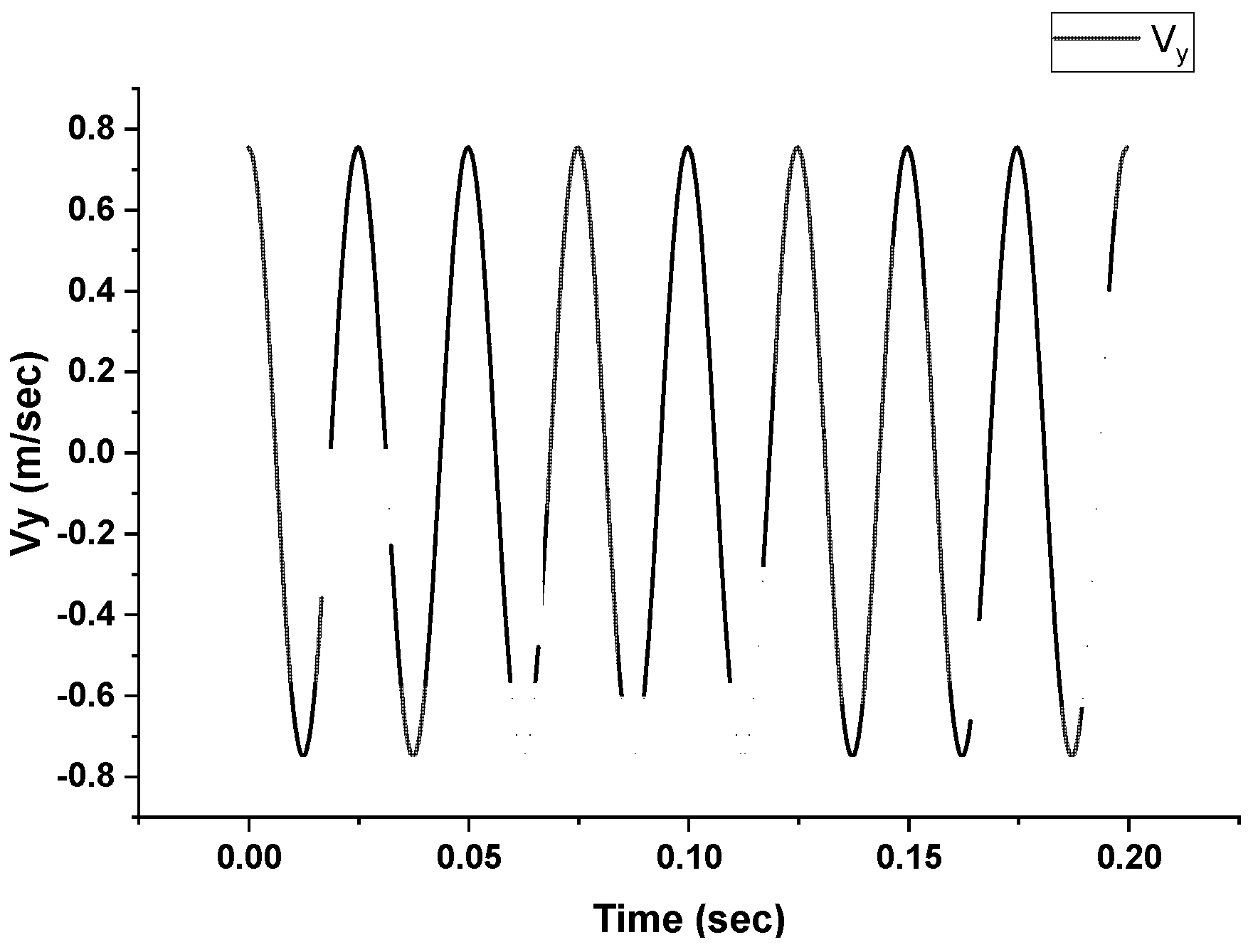
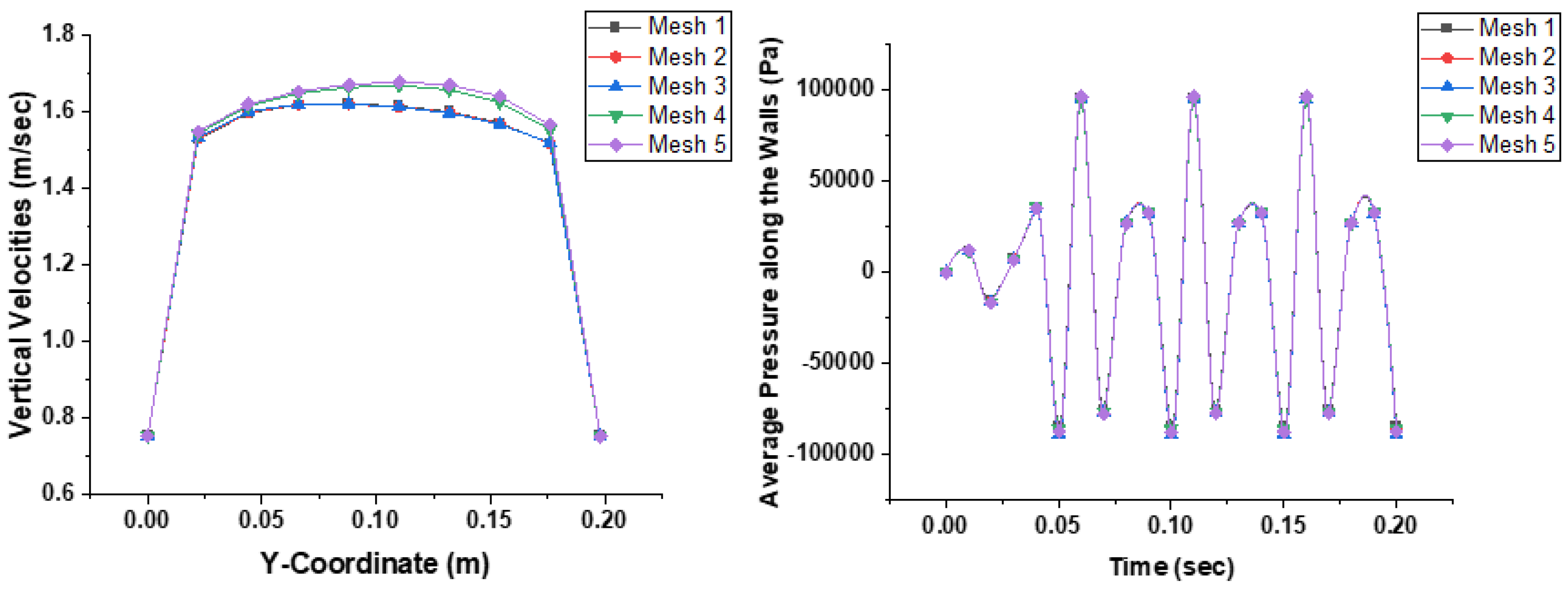
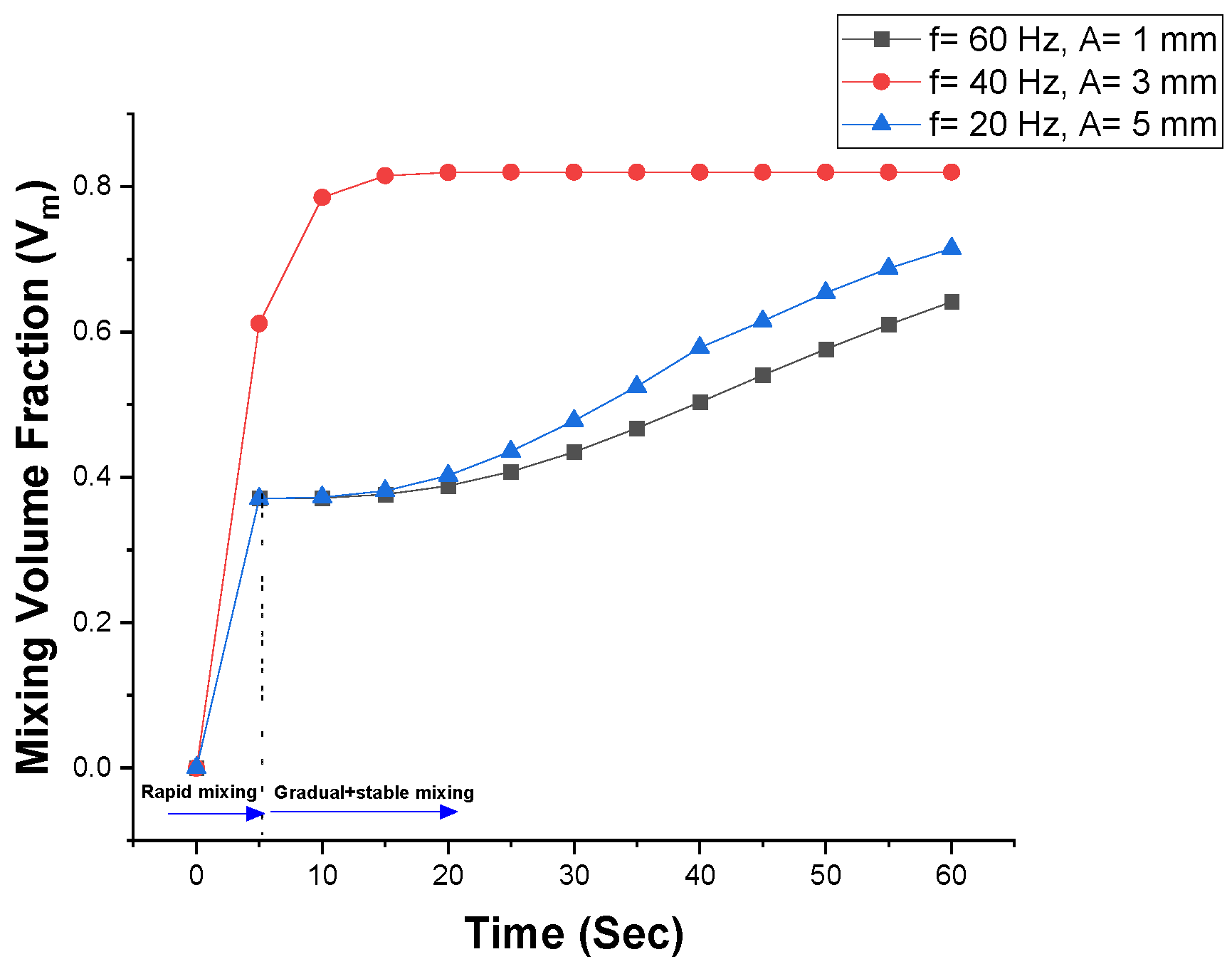
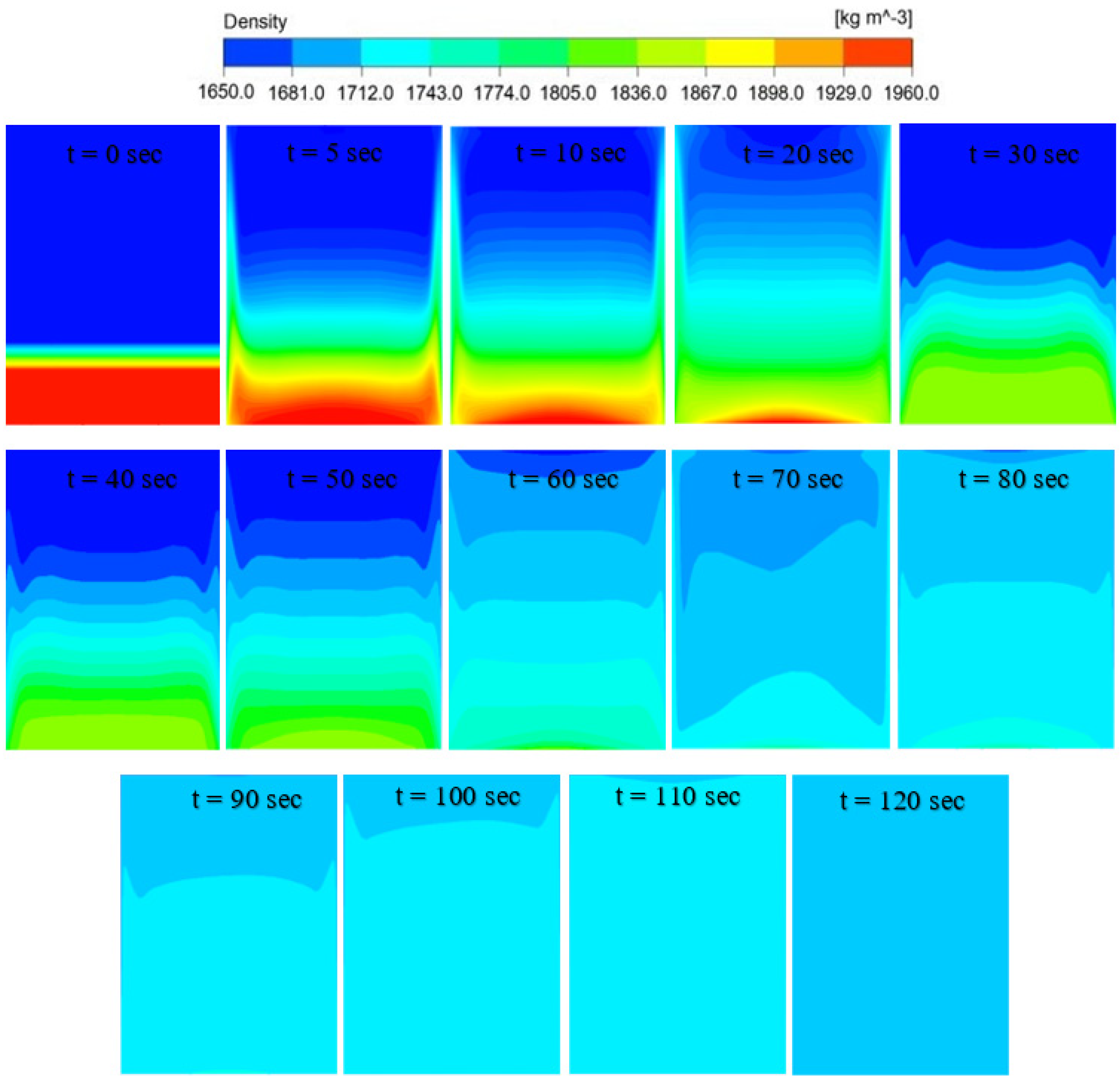


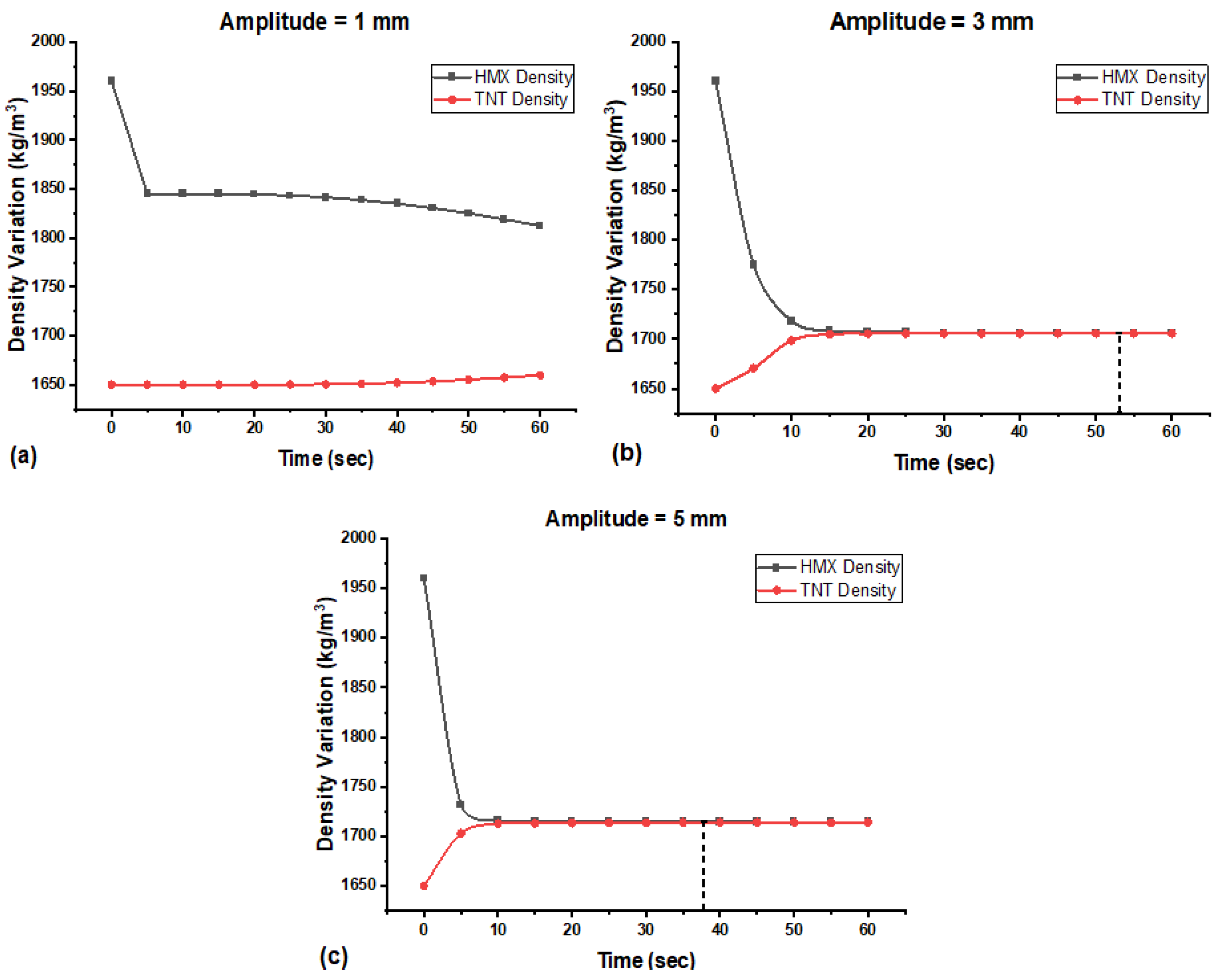

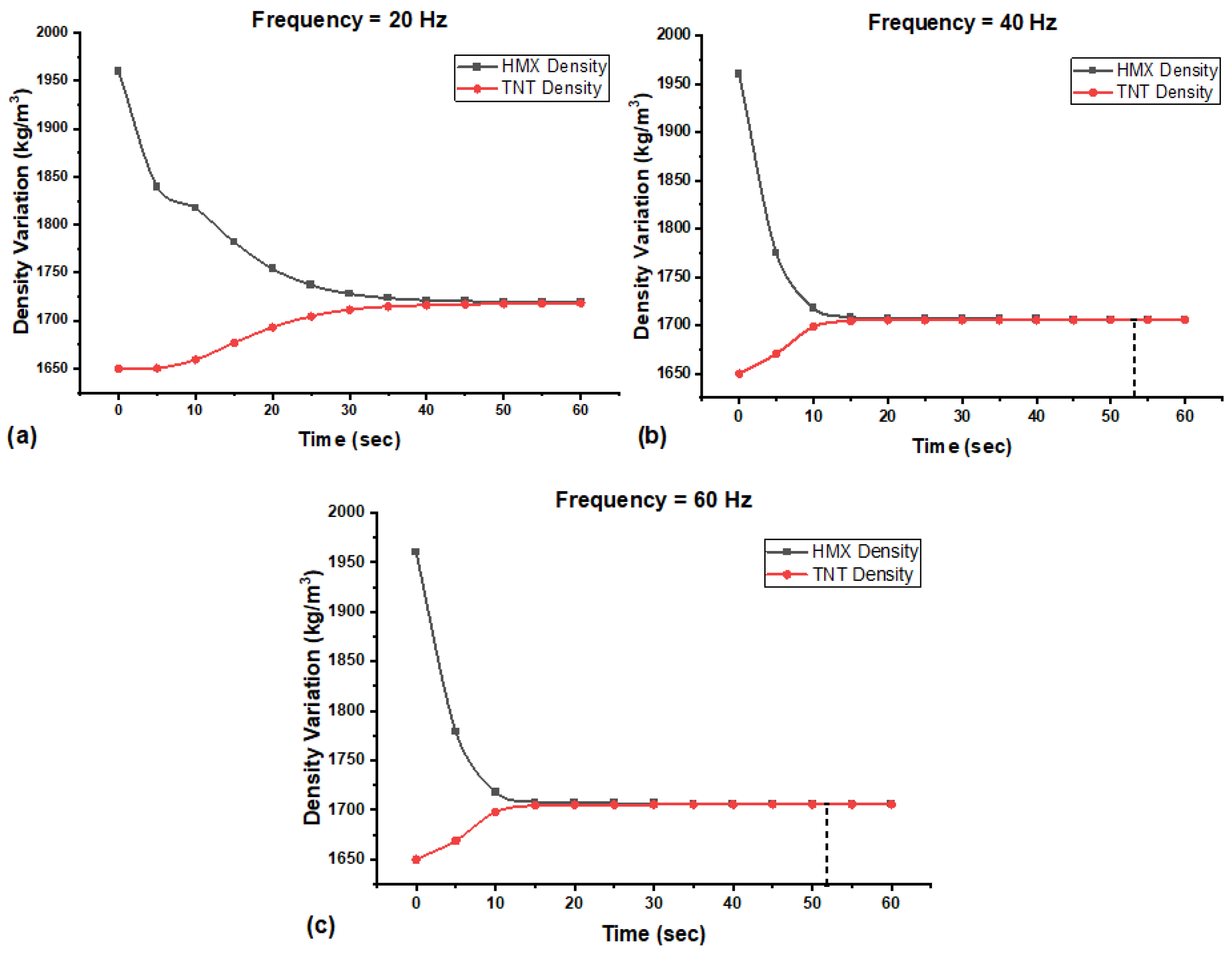
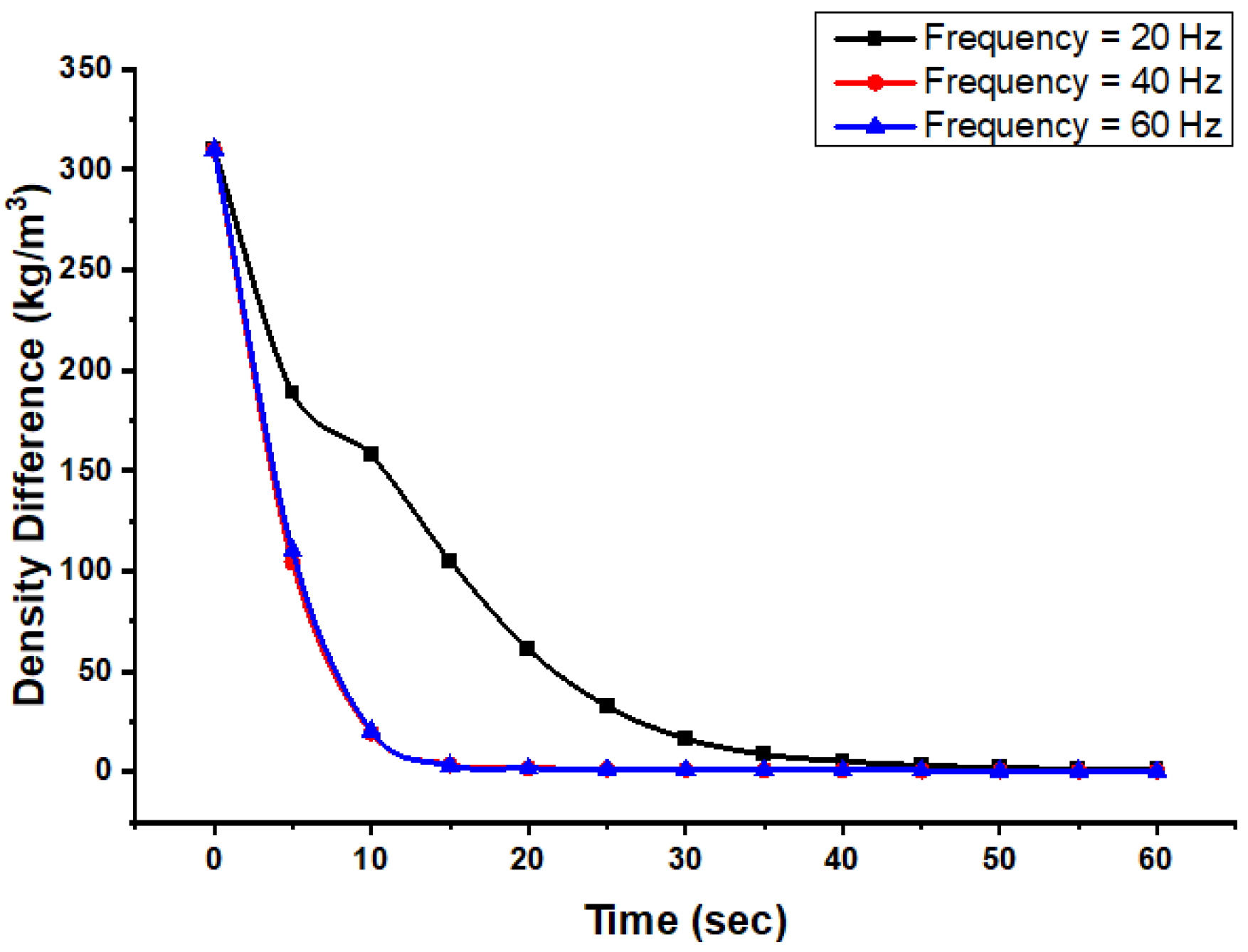

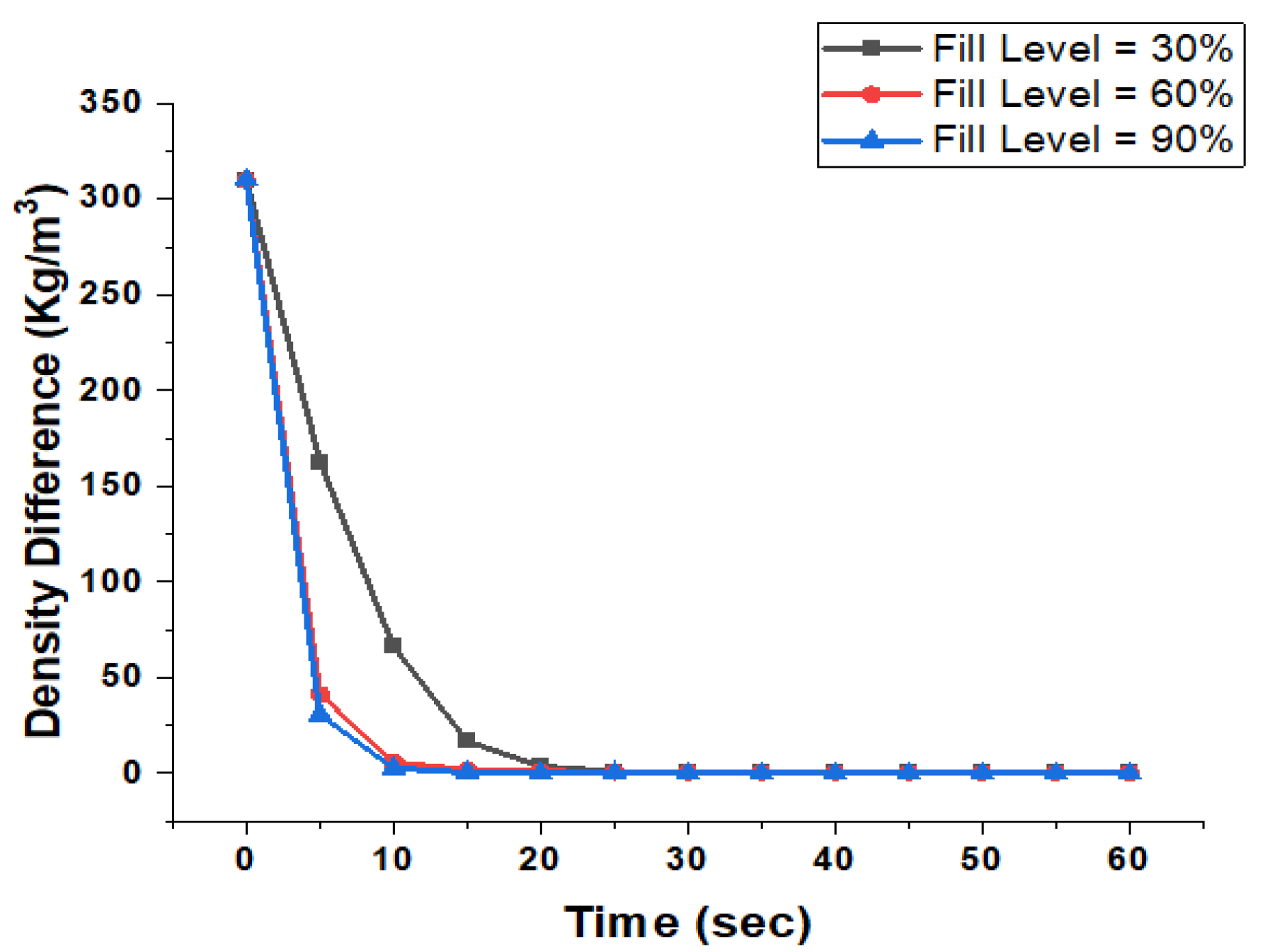
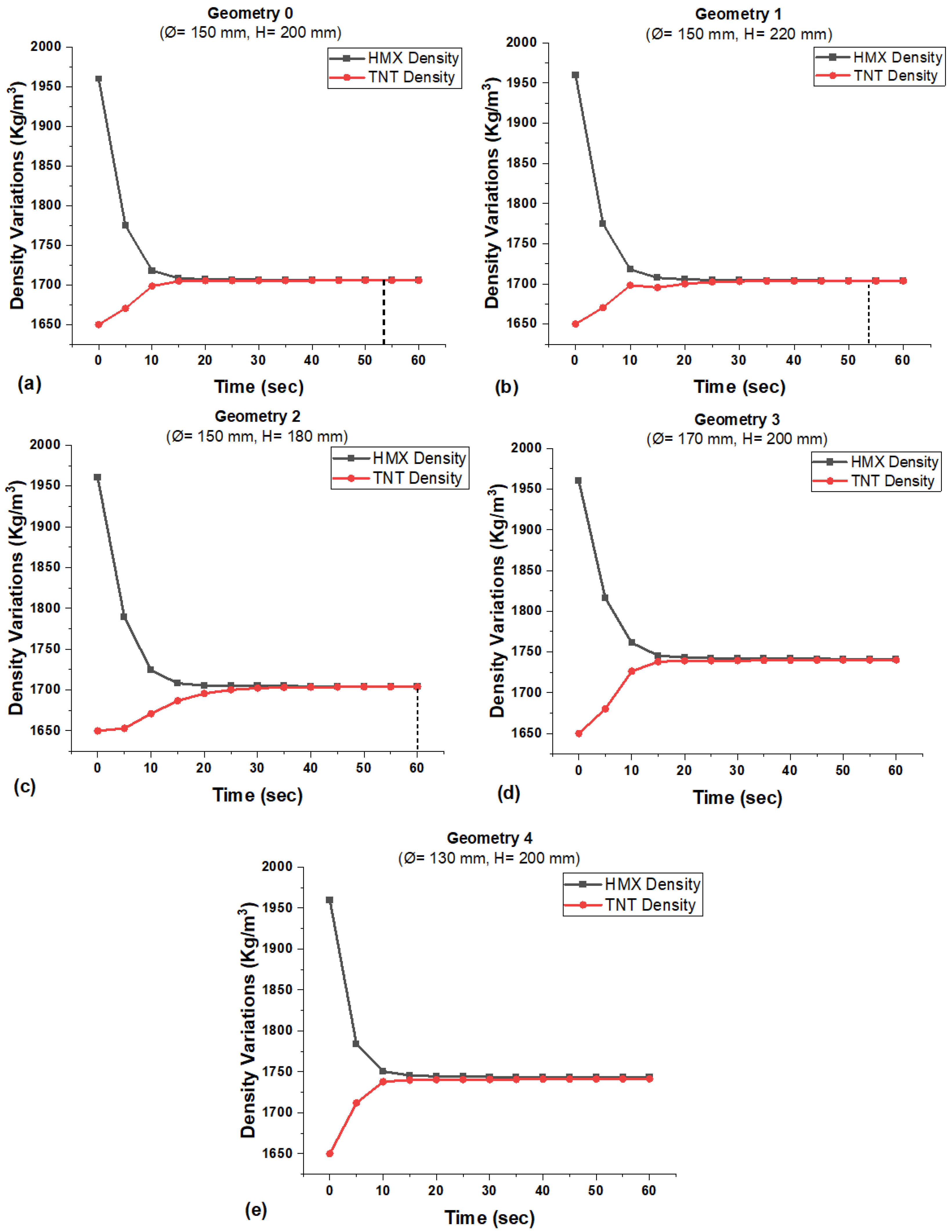
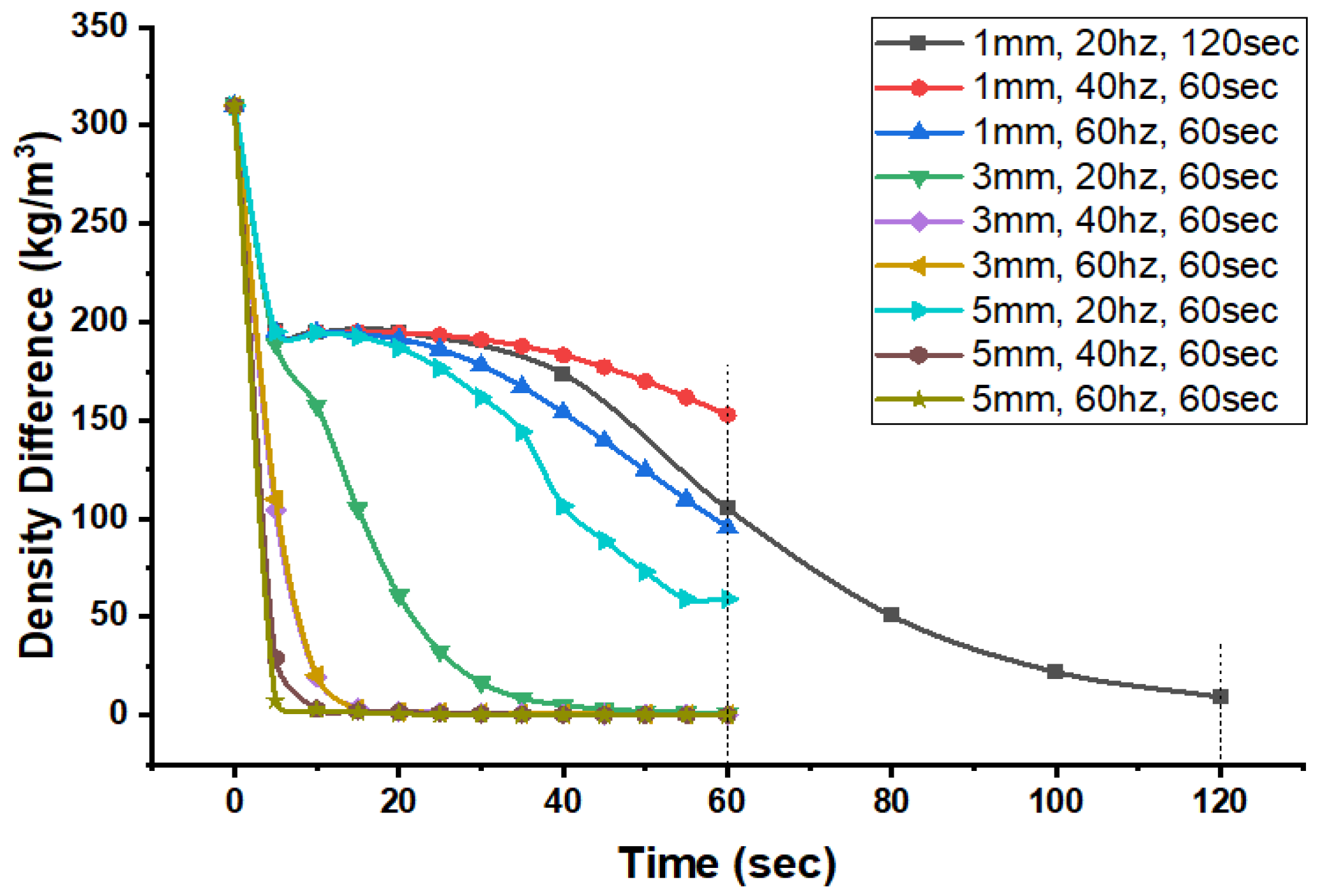
| Material Property | HMX | TNT |
|---|---|---|
| Density | 1960 kg/m3 | 1650 kg/m3 |
| Viscosity | 7.5 kg/m-sec | 7.5 kg/m-sec |
| Phase change temperature | 441 °K | 350 °K |
| Thermal conductivity | 0.51 W-m−1K−1 | 0.26 W-m−1K−1 |
| Detonation velocity | 9100 m/sec | 6900 m/sec |
| Melting point | 549 to 559 °K | 353.50 °K |
Disclaimer/Publisher’s Note: The statements, opinions and data contained in all publications are solely those of the individual author(s) and contributor(s) and not of MDPI and/or the editor(s). MDPI and/or the editor(s) disclaim responsibility for any injury to people or property resulting from any ideas, methods, instructions or products referred to in the content. |
© 2023 by the authors. Licensee MDPI, Basel, Switzerland. This article is an open access article distributed under the terms and conditions of the Creative Commons Attribution (CC BY) license (https://creativecommons.org/licenses/by/4.0/).
Share and Cite
Khan, I.U.; Guo, R.; Farooq, U.; Adhikari, S.; Zhou, H. Parametric Effects on the Mixing Efficiency of Resonant Acoustic Mixing Technology for High-Viscosity Mixture: A Numerical Study. Processes 2023, 11, 266. https://doi.org/10.3390/pr11010266
Khan IU, Guo R, Farooq U, Adhikari S, Zhou H. Parametric Effects on the Mixing Efficiency of Resonant Acoustic Mixing Technology for High-Viscosity Mixture: A Numerical Study. Processes. 2023; 11(1):266. https://doi.org/10.3390/pr11010266
Chicago/Turabian StyleKhan, Imdad Ullah, Rui Guo, Umar Farooq, Suraj Adhikari, and Hao Zhou. 2023. "Parametric Effects on the Mixing Efficiency of Resonant Acoustic Mixing Technology for High-Viscosity Mixture: A Numerical Study" Processes 11, no. 1: 266. https://doi.org/10.3390/pr11010266
APA StyleKhan, I. U., Guo, R., Farooq, U., Adhikari, S., & Zhou, H. (2023). Parametric Effects on the Mixing Efficiency of Resonant Acoustic Mixing Technology for High-Viscosity Mixture: A Numerical Study. Processes, 11(1), 266. https://doi.org/10.3390/pr11010266







